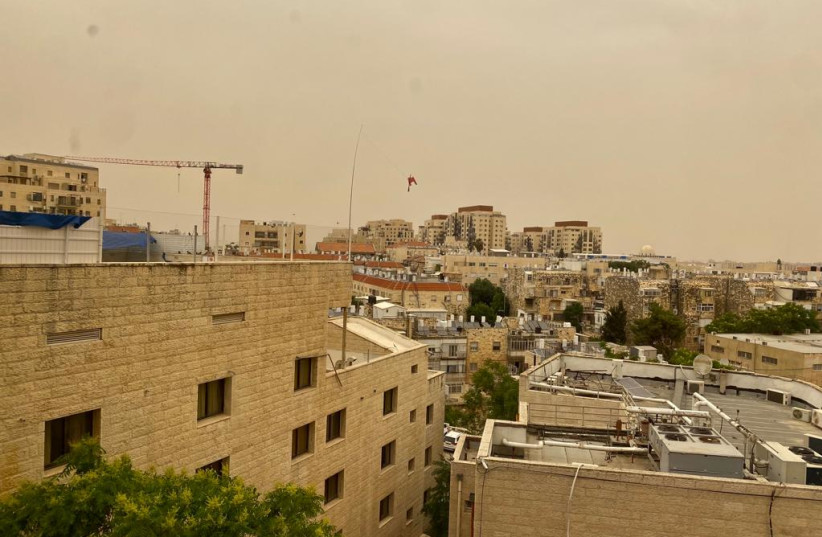Jerusalem Post
Death rates in region attributable to pollution is similar to other leading health risk factors such as tobacco smoking.
SEPTEMBER 28, 2022

(photo credit: The AQABA project)
When Israelis see that the skies have turned yellow and the air is hard to breathe, they automatically blame dust storms from the Arabian Peninsula for the sharav weather. But according to researchers in Germany, Saudi Arabia and Cyprus, this high level of air pollution in the whole Middle East is the result of anthropogenic activity – caused by humans.
Air pollution in the Middle East that is caused by humans contributes to health risks and is an important climate factor across the region. It accounts for around 745 per 100,000 excess deaths per year in the region, which is similar to other leading health risk factors, such as tobacco smoking and high cholesterol.
The study, just published in the prestigious journal Nature Communications under the title “Severe atmospheric pollution in the Middle East is attributable to anthropogenic sources,” was conducted by Sergey Osipov from the Max Planck Institute for Chemistry (MPI) in Mainz, Germany, with King Abdullah University of Science and Technology’s (KAUST) Georgiy Stenchikov and Alexander Ukhov and colleagues from King Saud University in Saudi Arabia and the Cyprus Institute in Nicosia.
The Middle East is located in the “dust belt” and experiences about 20 major dust storms per year. Boosted by the lack of precipitation, the elevated mineral dust concentrations have a profound effect on ecosystems, human activity and influence the climate by interacting with solar and terrestrial radiation.
“The conventional thinking was that dust carried by storms over the Arabian Peninsula dominated air quality over the region,” said Osipov.
A dust storm has covered Jerusalem in orange clouds and a thin layer of sand for the second time in a month (credit: Shira Silkoff)
“Our research has demonstrated that hazardous fine particulate matter, which is distinct from the less harmful coarse desert dust particles, is largely anthropogenic in origin and is a leading health risk factor, as well a significant contributor to climate change,” Osipov asserted.
Past models overestimated influence of desert dust
Previous modeling studies on air quality across the Middle East tend to overestimate the influence of desert dust, obscuring the contribution to poor air quality from anthropogenic sources, added Osipov. “Such models produce semi-correct answers for the wrong reason, because they poorly represent a significant component of anthropogenic fine particle pollution in the region.”
The lack of observation data, combined with a poor representation of emission sources, has “significantly hindered our ability to model the chemical composition of the atmosphere in the region,” he added.
To address this scarcity of data, a team headed by Jos Lelieveld from MPI collected measurements taken at sea as part of the international collaboration, that was called Air Quality and climate in the Arabian Basin (AQABA). The measurements, collected over two months during the summer of 2017, covered various ambient conditions ranging from pristine in the remote atmosphere to heavy pollution and dust storms.
An analysis of the AQABA data provided comprehensive constraints on the dust size distribution, which allowed more realistic simulation of the mass flux and life cycle of dust. As a result, the team was able to model the realistic chemical composition of the aerosol across the entire size range.
Unique combination of pollutants
A unique combination of pollutants present at abundant concentrations distinguishes ambient air pollution in the Middle East from other areas of the world, the researchers wrote. “Until now, air quality in the Middle East was considered to be primarily affected by the vast amounts of natural dust. The AQABA observations and model results reveal that this view is incorrect and that anthropogenic emissions are inherent and prominent. Human-caused particulate matter induces a radiative forcing equivalent to the abundant natural dust. Since aerosols are a major driver of climate and health impacts in the Middle East, the anthropogenic component should be adequately represented in assessments of air quality and climate change.”
They found that “particulate matter from human sources accounted for around 53% of aerosol visible optical depth and induces a radiative forcing on the climate equivalent to that of the natural dust in the region,” said Osipov. “Our study highlights how anthropogenic air pollution is a leading health risk and important climactic factor across the Middle East.”
The human footprint of the Middle East, with a population of about 400 million, is evident as the region emits more than 15% of the global sulfur dioxide (SO2) pollution and 7.5% of the greenhouse gases that include carbon dioxide, methane, nitrous oxide and fluorinated gases (hydrofluorocarbons, perfluorocarbons, sulfur hexafluoride and nitrogen trifluoride are synthetic that are emitted from a variety of household, commercial and industrial applications, processes and vehicle traffic).
“The Middle East is a major global SO2 emission hot spot, mostly from fossil energy production and the petrochemical,” they wrote. “Due to intense marine traffic, ship emissions contribute to the sulfate pollution and dominate the background sulfate concentrations in remote and pristine areas… Acidification accounts for many of the deleterious effects that air pollution exerts on ecosystems. Our simulations reveal that coastal regions are most intensely exposed to sulfur deposition, with the Red Sea, Arabian Gulf and the adjacent coasts of the Arabian Peninsula, as well as the Eastern Mediterranean area particularly affected. It is critical that the deleterious effects of “acid rain” be considered, especially in ambitious projects such as the Green Middle East and Saudi initiatives, whose aims include the planting of 40 billion trees in the region.”
https://www.jpost.com/environment-and-climate-change/article-718134
Researchers Find Real Reason the Air Quality in the Middle East Is So Bad – Haaretz
Sandstorms darkening the sky are practically cliché but it turns out they’re not the chief culprit

Ruth Schuster. Sep 29, 2022
Sandstorms in the Middle East are practically cliché. Yet these roaring dirt storms are a climatic trifle compared with the particulate pollution whipped up by humans in the Middle East, according to a study published in Nature Communications Earth & Environment in September. More than 90 percent of the fine particulate matter in the Middle East’s air is of anthropogenic origin, report Sergey Osipov and Jos Lelieveld of the Max Planck Institute for Chemistry and colleagues, based on both measurement and modeling.
Basically, storms come and go while the emissions are perennial. Yet the human contribution to the lousy quality of air in the Middle East has been overlooked, the authors explain – and the pollution is having a toll on public health.
In the Middle East, the team estimates, deaths from smog are numerically comparable to deaths from smoking and high cholesterol, they report – about 745 per 100,000 a year, on average.

Clearly the “fine particulate matter” in the air (in the professional jargon, PM2.5) always surpasses health guideline concentrations in the Middle East as a whole, and half of that category of particles does stem from sandstorms and dust storms. It is also telling that the PM2.5 category pollution is much worse in Kuwait, for example, than Cyprus, and Cyprus’ figures are worse than that of the U.S. and Germany – illustrating just how poor the air quality in the Middle East is, the team says. Also, if half of this matter stems from storms, but half stems from us, then half is preventable.
You wouldn’t be alone if you had assumed Middle Eastern sandstorms were the main cause of aerosols (particles in the air). “In the Middle East, desert dust is assumed to dominate air pollution, being in permanent violation of public health guidelines,” the paper begins. Researchers had assumed that the desert dust blowing all over the region would dominate measurements of both fine and coarse particles, obscuring our puny signal. But it isn’t so.
Of course, this could change and not in a good way. Climatologists warn that the Middle East faces intensifying aridification as climate change proceeds. Presently, the region averages about 20 major sand and dust storms each year, but the combination of barren land, soil degradation thanks to short-sighted and ill-thought water management and agricultural practices, rising temperatures, and the naturally strong winds suggests that number will grow.

Back to the air pollution study which made measurements on board ships sailing around the Arabian peninsula in 2017 and were augmented by atmospheric modeling, the team explains.
Frankly, to cognoscenti of pollution, the results are not shocking. For one thing, the Middle East has a population of about 400 million and the region’s ecological footprint is vast. Even before Lebanon made headlines this month for the sheer immensity of the emissions from generators used for power instead of the collapsed electricity infrastructure, the Middle East was responsible for more than 7.5 percent of global greenhouse gas emissions, and 15 percent of global sulfur dioxide emissions, which are terrible for the respiratory system.

But official representations of emissions have fallen short of full disclosure, the new paper explains, and observational data was also lacking, which constrained modeling. Hence the ship-borne measurement project, dubbed Aqaba – (Air Quality and climate in the Arabian Basin).
To drive home the point of how bad the air quality in the Middle East is for health, the authors of the study compare excess mortality from it, to the coronavirus. “Although not directly compatible (one being a health risk and the other a disease), the annual excess mortality attributable to poor air quality (11.5 percent due to PM2.5 and ozone) and that from COVID-19 (7.6 percent region-wise and 10.3 percent excluding Egypt, Syria and Yemen as low-outliers) are similar, but noting that the health impacts from air pollution are of long-term duration,” they write. Duly noted.

